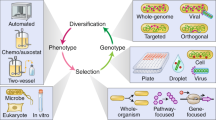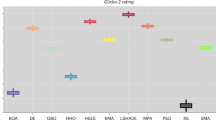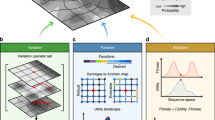Abstract
Evolutionary computation is inspired by the mechanisms of biological evolution. With algorithmic improvements and increasing computing resources, evolutionary computation has discovered creative and innovative solutions to challenging practical problems. This paper evaluates how today’s evolutionary computation compares to biological evolution and how it may fall short. A small number of well-accepted characteristics of biological evolution are considered: openendedness, major transitions in organizational structure, neutrality and genetic drift, multi-objectivity, complex genotype-to-phenotype mappings and co-evolution. Evolutionary computation exhibits many of these to some extent but more can be achieved by scaling up with available computing and by emulating biology more carefully. In particular, evolutionary computation diverges from biological evolution in three key respects: it is based on small populations and strong selection; it typically uses direct genotype-to-phenotype mappings; and it does not achieve major organizational transitions. These shortcomings suggest a roadmap for future evolutionary computation research, and point to gaps in our understanding of how biology discovers major transitions. Advances in these areas can lead to evolutionary computation that approaches the complexity and flexibility of biology, and can serve as an executable model of biological processes.
This is a preview of subscription content, access via your institution
Access options
Access Nature and 54 other Nature Portfolio journals
Get Nature+, our best-value online-access subscription
$29.99 / 30 days
cancel any time
Subscribe to this journal
Receive 12 digital issues and online access to articles
$119.00 per year
only $9.92 per issue
Buy this article
- Purchase on SpringerLink
- Instant access to full article PDF
Prices may be subject to local taxes which are calculated during checkout

Similar content being viewed by others
References
Holland, J. H. Outline for a logical theory of adaptive systems. J. ACM 9, 297–314 (1962).
Holland, J. H. Adaptation in Natural and Artificial Systems: An Introductory Analysis with Applications to Biology, Control, and Artificial Intelligence (Univ. Michigan Press, 1975).
Forrest, S. Genetic algorithms: principles of natural selection applied to computation. Science 261, 872–878 (1993).
Koza, J. R. Genetic Programming (MIT Press, 1992).
Beyer, H.-G. & Schwefel, H.-P. Evolution strategies: a comprehensive introduction. Nat. Comput. 1, 3–52 (2002).
Dasgupta, D. & Michalewicz, Z. (eds). Evolutionary Algorithms in Engineering Applications (Springer, 1997).
Greiner, D., Periaux, J., Quagliarella, D., Magalhaes-Mendes, J. & Galván, B. Evolutionary algorithms and metaheuristics: applications in engineering design and optimization. Math. Probl. Eng. 2018, 2793762 (2018).
Miettinen, K. & Neittaanmaki, P. Evolutionary Algorithms in Engineering and Computer Science: Recent Advances in Genetic Algorithms, Evolution Strategies, Evolutionary Programming, GE (Wiley, 1999).
Parmee, I. C. Evolutionary and Adaptive Computing in Engineering Design (Springer, 2001).
Johnson, A. J. et al. Flavor-cyber-agriculture: optimization of plant metabolites in an open-source control environment through surrogate modeling. PLoS ONE 14, e0213918 (2019).
Ling, S. H. & Lam, H. K. Evolutionary algorithms in health technologies. Algorithms 12, 202 (2019).
Wang, H., Jin, Y. & Jansen, J. Data-driven surrogate-assisted multi-objective evolutionary optimization of a trauma system. IEEE Trans. Evol. Comput. 20, 939–952 (2016).
Bongard, J. Evolutionary robotics. Commun. ACM 56, 74–85 (2013).
Cheney, N., Bongard, J., SunSpiral, V. & Lipson, H. Scalable co-optimization of morphology and control in embodied machines. J. R. Soc. Interface 15, 20170937 (2018).
Hornby, G. S., Lohn, J. D. & Linden, D. S. Computer-automated evolution of an X-band antenna for NASA’s space technology 5 mission. Evol. Comput. 19, 1–23 (2011).
van Eck Conradie, A., Miikkulainen, R. & Aldrich, C. Adaptive control utilising neural swarming. In Proceedings of the Genetic and Evolutionary Computation Conference 60–67 (2002).
Lehman, J. et al. The surprising creativity of digital evolution: a collection of anecdotes from the evolutionary computation and artificial life research communities. Artif. Life 26, 274–306 (2020).
Miranda, E. R. & Biles, J. A. (eds) Evolutionary Computer Music (Springer, 2006).
Romero, J. & Machado, P. (eds) The Art of Artificial Evolution: A Handbook on Evolutionary Art and Music (Springer, 2007).
Secretan, J. et al. Picbreeder: a case study in collaborative evolutionary exploration of design space. Evol. Comput. 19, 345–371 (2011).
Le Goues, C., Nguyen, T., Forrest, S. & Weimer, W. GenProg: a generic method for automated software repair. Trans. Software Eng. 38, 54–72 (2012).
Le Goues, C., Dewey-Vogt, M., Forrest, S. & Weimer, W. A systematic study of automated program repair: fixing 55 out of 105 bugs for $8 each. In International Conference on Software Engineering (IEEE, 2012).
Miikkulainen, R. et al. Evolving deep neural networks. In Artificial Intelligence in the Age of Neural Networks and Brain Computing (eds Morabito, C. F. et al.) Ch. 15, 293–312 (Elsevier, 2020).
Real, E., Aggarwal, A., Huang, Y. & Le, Q. V. Regularized evolution for image classifier architecture search. In Proceedings of the AAAI Conference on Artificial Intelligence 4780–4789 (AAAI, 2019).
Stephenson, M., Amarasinghe, S., Martin, M. & O’Reilly, U.-M. Meta optimization: improving compiler heuristics with machine learning. SIGPLAN Not. 38, 77–90 (2003).
Schulte, E., Dorn, J., Harding, S., Forrest, S. & Weimer, W. Post-compiler software optimization for reducing energy. In Architectural Support for Programming Languages and Operating Systems 639–652 (2014).
Banzhaf, W. et al. From artificial evolution to computational evolution: a research agenda. Nat. Rev. Genet. 7, 729–735 (2006).
Bedau, M. A. et al. Open problems in artificial life. Artif. Life 6, 363–376 (2000).
Lynch, M. The frailty of adaptive hypotheses for the origins of organismal complexity. Proc. Natl Acad. Sci. USA 104, 8597–8604 (2007).
Liow, L. H., Valen, L. & Stenseth, N. C. Red queen: from populations to taxa and communities. Trends Ecol. Evol. 26, 349–358 (2011).
Banzhaf, W. et al. Defining and simulating open-ended novelty: requirements, guidelines, and challenges. Theor. Biosci. 135, 131–161 (2016).
Stanley, K. O. Why open-endedness matters. Artif. Life 25, 232–235 (2019).
Smith, E. & Morowitz, H. J. Universality in intermediary metabolism. Proc. Natl Acad. Sci. USA 101, 13168–13173 (2004).
Stanley, K. O. & Miikkulainen, R. Evolving neural networks through augmenting topologies. Evol. Comput. 10, 99–127 (2002).
Lenski, R. E., Ofria, C., Collier, T. C. & Adami, C. Genome complexity, robustness, and genetic interactions in digital organisms. Nature 400, 661–664 (1999).
Ray, T. S. An approach to the synthesis of life. In Artificial Life II (eds Langton, C. G. et al.) 371–408 (Addison-Wesley, 1991).
Spector, L., Klein, J. & Feinstein, M. Division blocks and the open-ended evolution of development, form, and behavior. In Proceedings of the Genetic and Evolutionary Computation Conference (2007).
Maynard Smith, J. & Szathmary, E. The Major Transitions in Evolution (Oxford Univ. Press, 1997).
Szathmáry, E. Toward major evolutionary transitions theory 2.0. Proc. Natl Acad. Sci. USA 112, 10104–10111 (2015).
West, S. A., Fisher, R. M., Gardner, A. & Kiers, E. T. Major evolutionary transitions in individuality. Proc. Natl Acad. Sci. USA 112, 10112–10119 (2015).
Watson, R. A. & Pollack, J. B. A computational model of symbiotic composition in evolutionary transitions. Biosystems 69, 187–209 (2003).
Turney, P. D. Symbiosis promotes fitness improvements in the game of life. Artif. Life 26, 338–365 (2020).
Lessin, D., Fussell, D. & Miikkulainen, R. Open-ended behavioral complexity for evolved virtual creatures. In Proceedings of the Genetic and Evolutionary Computation Conference (GECCO) (2013).
Bershtein, S., Segal, M., Bekerman, R., Tokuriki, N. & Tawfik, D. Robustness-epistasis link shapes the fitness landscape of a randomly drifting protein. Nature 444, 929–932 (2006).
Kimura, M. The Neutral Theory of Molecular Evolution (Cambridge Univ. Press, 1985).
Wagner, A. et al. Robustness and Evolvability in Living Systems (Princeton Univ. Press, 2005).
Draghi, J., Parsons, T., Wagner, G. & Plotkin, J. Mutational robustness can facilitate adaptation. Nature 463, 353–355 (2010).
LaBar, T. & Adami, C. Different evolutionary paths to complexity for small and large populations of digital organisms. PLoS Comput. Biol. 12, e1005066 (2016).
Banzhaf, W. & Leier, A. Evolution on neutral networks in genetic programming. In Genetic Programming Theory and Practice III (eds Yu, T. et al.) 207–221 (Springer, 2006).
Milano, N. & Nolfi, S. Robustness to faults promotes evolvability: insights from evolving digital circuits. PLoS ONE 11, e0158627 (2016).
Smith, T., Husbands, P. & O’Shea, M. Neutral networks and evolvability with complex genotype-phenotype mapping. In Advances in Artificial Life 272–281 (2001).
Spector, L. & Robinson, A. Genetic programming and autoconstructive evolution with the push programming language. Genet. Program. Evolvable Mach. 3, 7–40 (2002).
Yu, T. & Miller, J. F. Through the interaction of neutral and adaptive mutations, evolutionary search finds a way. Artif. Life 12, 525–551 (2006).
Stanley, K. O. & Lehman, J. Why Greatness Cannot Be Planned: The Myth of the Objective (Springer, 2015).
Varadarajan, S. & Whitley, D. The massively parallel mixing genetic algorithm for the traveling salesman problem. In Proceedings of the Genetic and Evolutionary Computation Conference, GECCO ’19 872–879 (ACM, 2019).
Harrand, N., Allier, S., Rodriguez-Cancio, M., Monperrus, M. & Baudry, B. A journey among Java neutral program variants. Genet. Program. Evolvable Mach. 20, 531–580 (2019).
Schulte, E., Fry, Z. P., Fast, E., Weimer, W. & Forrest, S. Software mutational robustness. Genet. Program. Evolvable Mach. 15, 281–312 (2014).
Veerapen, N., Daolio, F. & Ochoa, G. Modelling genetic improvement landscapes with local optima networks. In Proceedings of the Genetic and Evolutionary Computation Conference Companion 1543–1548 (2017).
Renzullo, J., Weimer, W., Moses, M., and Forrest, S. Neutrality and epistasis in program space. In ICSE Genetic Improvement Workshop (2018).
Liou, J.-Y., Wang, X., Forrest, S. & Wu, C.-J. GEVO: GPU code optimization using evolutionary computation. ACM Trans. Archit. Code Optimiz. 17, 33 (2020).
Cowperthwaite, M. C., Bull, J. J. & Meyers, L. A. From bad to good: fitness reversals and the ascent of deleterious mutations. PLoS Comput. Biol. 2, e141 (2006).
LaBar, T. & Adami, C. Evolution of drift robustness in small populations. Nat. Commun. 8, 1012 (2017).
Levin, B. R., Perrot, V. & Walker, N. Compensatory mutations, antibiotic resistance and the population genetics of adaptive evolution in bacteria. Genetics 154, 985–997 (2000).
Moore, F. B.-G., Rozen, D. E. & Lenski, R. E. Pervasive compensatory adaptation in Escherichia coli. Proc. R. Soc. Lon. B 267, 515–522 (2000).
Fogel, D. B. Blondie24: Playing at the Edge of AI (Kaufmann, 2001).
Grasm, R., Golestani, A., Hendry, A. P. & Cristescu, M. E. Speciation without pre-defined fitness functions. PLoS ONE 10, e0137838 (2015).
Hu, Y. et al. Application of evolutionary computation for rule discovery in stock algorithmic trading: a literature review. Appl. Soft Comput. 36, 534–551 (2015).
Coello Coello, C. A., Van Veldhuizen, D. A. & Lamont, G. B. Evolutionary Algorithms for Solving Multi-Objective Problems (Springer, 2007).
Liang, J., et al. Evolutionary neural AutoML for deep learning. In Proceedings of the Genetic and Evolutionary Computation Conference (GECCO-2019) 401–409 (2019).
Schwaab, J. et al. Improving the performance of genetic algorithms for land-use allocation problems. Int. J. Geogr. Inf. Sci. 32, 907–930 (2018).
Deb, K., Pratab, A., Agrawal, S. & Meyarivan, T. A fast and elitist multi-objective genetic algorithm: NSGA-II. IEEE Trans. Evol. Comput. 6, 181–197 (2002).
Deb, K. & Jain, H. An evolutionary many-objective optimization algorithm using reference-point-based nondominated sorting approach, part I: solving problems with box constraints. IEEE Trans. Evol. Comput. 18, 577–601 (2014).
LaCava, W., Helmuth, T., Spector, L. & Moore, J. H. A probabilistic and multi-objective analysis of lexicase selection and ϵ -lexicase selection. Evol. Comput. 27, 377–402 (2019).
Anceschi, N. et al. Neutral and niche forces as drivers of species selection. J. Theor. Biol. 483, 109969 (2019).
Dieckmann, U. & Doebeli, M. On the origin of species by sympatric speciation. Nature 400, 354–357 (1999).
Mahfoud, S. W. Niching Methods for Genetic Algorithms. PhD thesis, Univ. Illinois at Urbana-Champaign (1995).
Meyerson, E., Lehman, J. & Miikkulainen, R. Learning behavior characterizations for novelty search. In Proceedings of the Genetic and Evolutionary Computation Conference (GECCO) 149–156 (2016).
Pugh, J. K., Soros, L. B., Szerlip, P. A. & Stanley, K. O. Confronting the challenge of quality diversity. In Proceedings of the 2015 Annual Conference on Genetic and Evolutionary Computation 967–974 (2015).
Wang, Y. Gene regulatory networks. In Encyclopedia of Systems Biology (eds Dubitzky, W. et al.) 801–805 (Springer, 2013).
Lind, M. & Spagopoulou, F. Evolutionary consequences of epigenetic inheritance. Heredity 121, 205–209 (2018).
Muller, G. B. Evo-devo Extending the evolutionary synthesis. Nat. Rev. Genet. 8, 943–949 (2007).
Bentley, P. J. Evolving fractal gene regulatory networks for robot control. In Advances in Artificial Life (eds Banzhaf, W. et al.) 753–762 (Springer, 2003).
Payne, J. L., Moore, J. H. & Wagner, A. Robustness, evolvability, and the logic of genetic regulation. Artif. Life 20, 111–126 (2014).
Reisinger, J. & Miikkulainen, R. Acquiring evolvability through adaptive representations. In Proceeedings of the Genetic and Evolutionary Computation Conference 1045–1052 (2007).
Wang, Q. et al. Epigenetic game theory: how to compute the epigenetic control of maternal-to-zygotic transition. Phys. Life Rev. 20, 126–137 (2017).
Stanley, K. O., Clune, J., Lehman, J. & Miikkulainen, R. Designing neural networks through evolutionary algorithms. Nat. Mach. Intell. 1, 24–35 (2019).
Stanley, K. O., D’Ambrosio, D. B. & Gauci, J. A hypercube-based encoding for evolving large-scale neural networks. Artif. Life 15, 185–212 (2009).
Gruau, F. & Whitley, D. Adding learning to the cellular development of neural networks: evolution and the Baldwin effect. Evol. Comput. 1, 213–233 (1993).
Such, F. P. et al. Deep neuroevolution: genetic algorithms are a competitive alternative for training deep neural networks for reinforcement learning. In NeurIPS Deep Reinforcement Learning Workshop (2017).
Banzhaf, W., Francone, F. D., Keller, R. E. & Nordin, P. Genetic Programming: An Introduction: On the Automatic Evolution of Computer Programs and Its Applications (Kaufmann, 1998).
Gomez, F., Schmidhuber, J. & Miikkulainen, R. Accelerated neural evolution through cooperatively coevolved synapses. J. Mach. Learn. Res. 9, 937–965 (2008).
Helms, L. & Clune, J. Improving hybrid: how to best combine indirect and direct encoding in evolutionary algorithms. PLoS ONE 12, e0174635 (2017).
Schrum, J., Gillespie, L. E. & Gonzalez, G. R. Comparing direct and indirect encodings using both raw and hand-designed features in tetris. In Proceedings of the Genetic and Evolutionary Computation Conference 179–186 (ACM, 2017).
Nuismer, S. Introduction to Coevolutionary Theory (Freeman, 2017).
Popovici, E., Bucci, A., Wiegand, P. & De Jong, E. In Handbook of Natural Computing (Rozenberg, G. et al.) 987–1033 (Springer, 2010).
de Jong, E. D. & Pollack, J. B. Ideal evaluation from coevolution. Evol. Comput. 12, 159–192 (2004).
Ficici, S. G. & Pollack, J. B. Pareto optimality in coevolutionary learning. In Sixth European Conference on Artificial Life (ed. Kelemen, J.) 316–325 (Springer, 2001).
Samuel, A. In Computers and Thought (eds Feigenbaum, E. A. & Feldman, J. A.) 210–229 (McGraw-Hill, 1963).
Silver, D. et al. A general reinforcement learning algorithm that masters chess, shogi, and go through self-play. Science 362, 1140–1144 (2018).
Sipper, M., Moore, J. H. & Urbanowicz, R. J. In Genetic Programming (eds Sekanina, L. et al.) 146–161 (Springer, 2019).
Hillis, W. D. Co-evolving parasites improve simulated evolution as an optimization procedure. Physica D 42, 228–234 (1990).
Wang, R., Lehman, J., Clune, J. & Stanley, K. O. POET: Open-ended coevolution of environments and their optimized solutions. In Proceedings of the Genetic and Evolutionary Computation Conference, GECCO 2019, Prague, Czech Republic, July 13-17, 2019 142–151 (2019).
Schmidt, M. & Lipson, H. Distilling free-form natural laws from experimental data. Science 324, 81–85 (2009).
Rawal, A., Rajagopalan, P. & Miikkulainen, R. Constructing competitive and cooperative agent behavior using coevolution. In IEEE Conference on Computational Intelligence and Games (CIG 2010) (2010).
Goodfellow, I. et al. Generative adversarial nets. In Advances in Neural Information Processing Systems 27 (eds Ghahramani, Z. et al.) 2672–2680. (Curran Associates, 2014).
Wang, C., Xu, C., Yao, X. & Tao, D. Evolutionary generative adversarial networks. IEEE Trans. Evol. Comput. 23, 921–934 (2019).
Potter, M. A. & Jong, K. A. D. Cooperative coevolution: an architecture for evolving coadapted subcomponents. Evol. Comput. 8, 1–29 (2000).
Gerules, G. & Janikow, C. A survey of modularity in genetic programming. In 2016 IEEE Congress on Evolutionary Computation (CEC) 5034–5043 (2016).
Chollet, F. On the measure of intelligence. Preprint at https://arxiv.org/abs/01547 (2019).
Goldberg, D. E. & Richardson, J. Genetic algorithms with sharing for multimodal function optimization. In Proceedings of the Second International Conference on Genetic Algorithms (1987).
Hansen, N. The CMA evolution strategy: a tutorial. Preprint at https://arxiv.org/abs/1604.00772 (2016).
Davidson, E. & Erwin, D. Gene regulatory networks and the evolution of animal body plans. Science 311, 796–800 (2006).
Hendriks-Jansen, H. Catching Ourselves in the Act. Situated Activity, Interactive Emergence, and Human Thought (MIT Press, 1996).
Stanley, K. O. & Miikkulainen, R. Competitive coevolution through evolutionary complexification. J. Artif. Intell. Res. 21, 63–100 (2004).
Acknowledgements
We thank R. Axelrod, D. Erwin, A. Graham and M. Mitchell for their suggestions on an earlier version of this paper, and R. Lenski and M. Lynch for many helpful discussions on evolution. Thanks to P. Reiter, F. Gomez and C. Schoolland for the original drawings for Fig. 1a–c. R.M. was partially supported by NSF DBI-0939454, DARPA FA8750-18-C-0103 and HR0011-18-2-0024, and NIH 1U01DC014922; S.F. was partially supported by NSF CCF-1908633 and IOS 2029696, DARPA FA8750-19C-0003 and N6600120C4020, and AFRL FA8750-19-1-0501; both R.M. and S.F. were supported by NSF IIS-2020103.
Author information
Authors and Affiliations
Corresponding authors
Ethics declarations
Competing interests
The authors declare no competing interests.
Additional information
Peer review information Nature Machine Intelligence thanks Christoph Adami, Julian Miller and the other, anonymous, reviewer(s) for their contribution to the peer review of this work.
Publisher’s note Springer Nature remains neutral with regard to jurisdictional claims in published maps and institutional affiliations.
Rights and permissions
About this article
Cite this article
Miikkulainen, R., Forrest, S. A biological perspective on evolutionary computation. Nat Mach Intell 3, 9–15 (2021). https://doi.org/10.1038/s42256-020-00278-8
Received:
Accepted:
Published:
Issue Date:
DOI: https://doi.org/10.1038/s42256-020-00278-8
This article is cited by
-
Computational thinking through the lens of biological evolution learning: enhancing understanding through the levels of biological organization and computational complexity
Evolution: Education and Outreach (2024)
-
Light-driven eco-evolutionary dynamics in a synthetic replicator system
Nature Chemistry (2024)
-
Maximum Lyapunov exponent-based multiple chaotic slime mold algorithm for real-world optimization
Scientific Reports (2023)
-
Machine learning-enabled globally guaranteed evolutionary computation
Nature Machine Intelligence (2023)
-
Bird’s Eye View feature selection for high-dimensional data
Scientific Reports (2023)




